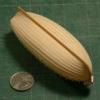-
Posts
13,322 -
Joined
-
Last visited
Content Type
Profiles
Forums
Gallery
Events
Everything posted by druxey
-
Examples of wooden pin in the Royal Museums Greenwich collection range from 43 to 49 cm (17" to 19") in length and 4 to 5 cm (1 1/2" to 2") in maximum diameter.
-

How will laser cutters compliment our hobby tomorrow?
druxey replied to EspenT's topic in 3D-Printing and Laser-Cutting.
Tomorrow is already here!Pparts that are 3D printed are really high resolution now, but items such as carved work lack a certain 'life' and look too perfect. -
I simply use a coffee mug warmer as not a large container is needed for model parts.
- 257 replies
-
- pegasus
- Swan-class
-
(and 1 more)
Tagged with:
-

Swan class 3D model in progress
druxey replied to dvm27's topic in CAD and 3D Modelling/Drafting Plans with Software
Lovely but, as someone else pointed out, the water drainage holes in the spritsail are still needed.- 141 replies
-
- pof swan series
- swan
-
(and 1 more)
Tagged with:
-
I usually dip the parts in water after Sparex before blackening. You don't want to contaminate the blackening agent! (Acetone shouldnot be necessary unless you touch the parts between steps in processing.)
- 257 replies
-
- pegasus
- Swan-class
-
(and 1 more)
Tagged with:
-
Different chemicals are involved for blackening pewter than for brass/copper. For pewter selenious acid, for copper or brass one of several sulphur compounds. Diluting the solution slows the chemical reaction and produces a thinner and more stable surface layer.
- 257 replies
-
- pegasus
- Swan-class
-
(and 1 more)
Tagged with:
-

Swan class 3D model in progress
druxey replied to dvm27's topic in CAD and 3D Modelling/Drafting Plans with Software
The translucency of the sails in 'sunlight' is very impressive!- 141 replies
-
- pof swan series
- swan
-
(and 1 more)
Tagged with:
-
Are you referring to the fish davit? It can be mounted port or starboard as required. See TFFM, 12.7 to 12.9.
- 257 replies
-
- pegasus
- Swan-class
-
(and 1 more)
Tagged with:
-
Actually, one has better control using a larger tool. You will file across the transom rather than along it. (For model work I usually use a ½" bevel edge chisel - or larger - a lot of the time. One can judge angles more easily than with a narrow tool.)
- 39 replies
-
- Norwegian Sailing Pram
- Model Shipways
-
(and 1 more)
Tagged with:
-
Having the transom too far aft may come back to bite you. The planks may fall short at either bow or stern. I'd go for the isopropanol for a do-over. It won't hurt a bit!
- 28 replies
-
- Lowell Grand Banks Dory
- Model Shipways
-
(and 1 more)
Tagged with:
About us
Modelshipworld - Advancing Ship Modeling through Research
SSL Secured
Your security is important for us so this Website is SSL-Secured
NRG Mailing Address
Nautical Research Guild
237 South Lincoln Street
Westmont IL, 60559-1917
Model Ship World ® and the MSW logo are Registered Trademarks, and belong to the Nautical Research Guild (United States Patent and Trademark Office: No. 6,929,264 & No. 6,929,274, registered Dec. 20, 2022)
Helpful Links
About the NRG
If you enjoy building ship models that are historically accurate as well as beautiful, then The Nautical Research Guild (NRG) is just right for you.
The Guild is a non-profit educational organization whose mission is to “Advance Ship Modeling Through Research”. We provide support to our members in their efforts to raise the quality of their model ships.
The Nautical Research Guild has published our world-renowned quarterly magazine, The Nautical Research Journal, since 1955. The pages of the Journal are full of articles by accomplished ship modelers who show you how they create those exquisite details on their models, and by maritime historians who show you the correct details to build. The Journal is available in both print and digital editions. Go to the NRG web site (www.thenrg.org) to download a complimentary digital copy of the Journal. The NRG also publishes plan sets, books and compilations of back issues of the Journal and the former Ships in Scale and Model Ship Builder magazines.



